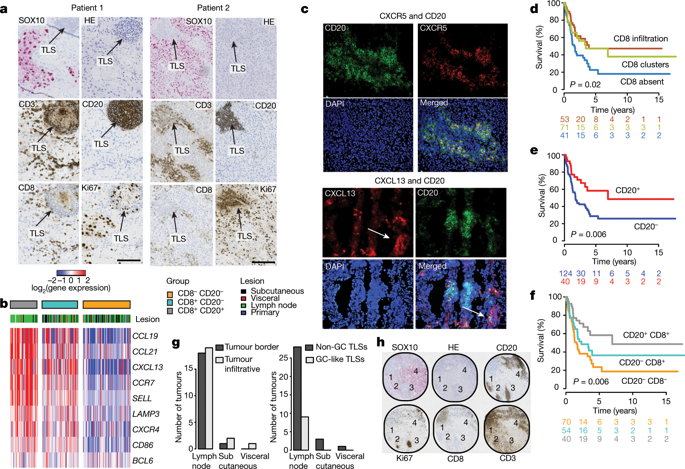Nature ( IF 64.8 ) Pub Date : 2020-01-15 , DOI: 10.1038/s41586-019-1914-8 Rita Cabrita 1 , Martin Lauss 1 , Adriana Sanna 1 , Marco Donia 2 , Mathilde Skaarup Larsen 3 , Shamik Mitra 1 , Iva Johansson 1 , Bengt Phung 1 , Katja Harbst 1 , Johan Vallon-Christersson 1 , Alison van Schoiack 4 , Kristina Lövgren 1 , Sarah Warren 4 , Karin Jirström 1 , Håkan Olsson 1 , Kristian Pietras 5 , Christian Ingvar 6 , Karolin Isaksson 6 , Dirk Schadendorf 7 , Henrik Schmidt 8 , Lars Bastholt 9 , Ana Carneiro 1, 10 , Jennifer A Wargo 11 , Inge Marie Svane 2 , Göran Jönsson 1

|
Checkpoint blockade therapies that reactivate tumour-associated T cells can induce durable tumour control and result in the long-term survival of patients with advanced cancers1. Current predictive biomarkers for therapy response include high levels of intratumour immunological activity, a high tumour mutational burden and specific characteristics of the gut microbiota2,3. Although the role of T cells in antitumour responses has thoroughly been studied, other immune cells remain insufficiently explored. Here we use clinical samples of metastatic melanomas to investigate the role of B cells in antitumour responses, and find that the co-occurrence of tumour-associated CD8+ T cells and CD20+ B cells is associated with improved survival, independently of other clinical variables. Immunofluorescence staining of CXCR5 and CXCL13 in combination with CD20 reveals the formation of tertiary lymphoid structures in these CD8+CD20+ tumours. We derived a gene signature associated with tertiary lymphoid structures, which predicted clinical outcomes in cohorts of patients treated with immune checkpoint blockade. Furthermore, B-cell-rich tumours were accompanied by increased levels of TCF7+ naive and/or memory T cells. This was corroborated by digital spatial-profiling data, in which T cells in tumours without tertiary lymphoid structures had a dysfunctional molecular phenotype. Our results indicate that tertiary lymphoid structures have a key role in the immune microenvironment in melanoma, by conferring distinct T cell phenotypes. Therapeutic strategies to induce the formation of tertiary lymphoid structures should be explored to improve responses to cancer immunotherapy.
中文翻译:

三级淋巴结构改善黑色素瘤的免疫治疗和存活率
重新激活肿瘤相关 T 细胞的检查点阻断疗法可以诱导持久的肿瘤控制并导致晚期癌症患者的长期生存1。目前治疗反应的预测性生物标志物包括高水平的肿瘤内免疫活性、高肿瘤突变负担和肠道微生物群的特定特征2,3。尽管已经彻底研究了 T 细胞在抗肿瘤反应中的作用,但其他免疫细胞仍然没有得到充分探索。在这里,我们使用转移性黑色素瘤的临床样本来研究 B 细胞在抗肿瘤反应中的作用,并发现肿瘤相关的 CD8 + T 细胞和 CD20 +B 细胞与提高生存率有关,与其他临床变量无关。CXCR5 和 CXCL13 与 CD20 结合的免疫荧光染色揭示了这些 CD8 + CD20 +肿瘤中三级淋巴结构的形成。我们得出了与三级淋巴结构相关的基因特征,该特征预测了接受免疫检查点阻断治疗的患者队列的临床结果。此外,富含 B 细胞的肿瘤伴随着 TCF7 +水平升高幼稚和/或记忆 T 细胞。数字空间分析数据证实了这一点,其中没有三级淋巴结构的肿瘤中的 T 细胞具有功能失调的分子表型。我们的研究结果表明,三级淋巴结构通过赋予不同的 T 细胞表型,在黑色素瘤的免疫微环境中起关键作用。应探索诱导三级淋巴结构形成的治疗策略,以改善对癌症免疫治疗的反应。



























 京公网安备 11010802027423号
京公网安备 11010802027423号